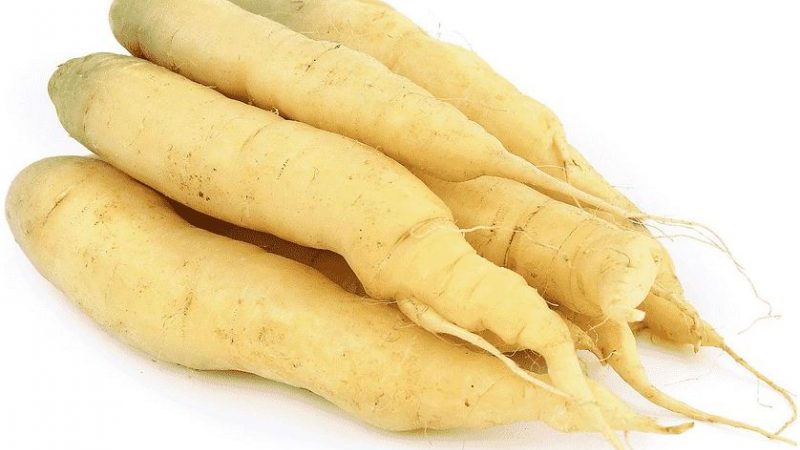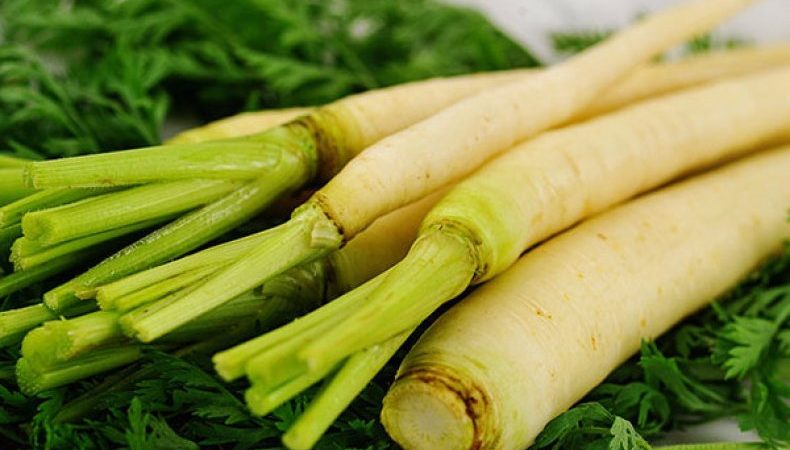Varieties of white carrots and their beneficial properties for the human body
Carrots are orange, red, yellow and nearly black. It even happens white. In this article, you will find out what white carrots are, what they are, why they lost their color, whether they are good for humans and whether there are contraindications to their use.
The content of the article
What is White Carrot
White carrots? White color means that it has no plant pigments. Mutation? An agricultural technician's mistake? Can such a vegetable be eaten? Similar questions arise for everyone who sees such a root crop for the first time.
Did you know that carrots originally had a completely different color from which we are used to seeing? Initially, it was exactly white, bitter and was suitable only for animal feed. Then yellow, red and even purple varieties appeared. And only in the 17th century, Dutch breeders received not only orange color, but also the usual taste of a root crop. The orange variety became the most popular in the world and remains so to this day.
Reference. Carrots are considered the only vegetable in the world whose properties and taste are not only not lost during heat treatment, but also improved.
Why is she white
Milky-colored carrots are an independent culture that has its own varieties and characteristics. If you sowed orange carrots in the garden, and grew colorless, then this is most likely poor-quality seed or growing errors. Such a vegetable is bitter, clumsy in appearance and has a color rather than even white, but unpleasantly gray. We can say that such a root crop has run wild again without proper care, and it is better to get rid of it.
Another thing is varietal white carrots. Vegetable pigments found in vegetables give them different colors. Carotene gives orange color, lutein - yellow, anthocyan - red, purple and even the black, depending on the amount of substance. And white carrots have no pigment.
Origin and development
Modern varieties of white vegetables were bred by breeders several decades ago. They were based on oriental varieties of yellow carrots. This was done by replacing beta-carotene with an element that produces vitamin E.
The result of the work was white carrots, a distant relative of a wild plant, that is, it turns out that the breeders returned to where they started. But unlike its wild relative, modern discolored carrots are not bitter at all and have a rich composition of vitamins and minerals. This species is suitable for a temperate climate, therefore it grows well in our country.
What is the difference between white and orange carrots
In addition to color, a white vegetable is not much different in appearance from an orange one. Unless the tops of some varieties are more like parsley. White carrots are divided into fodder and table varieties; they have a cylindrical, elongated rhizome up to 17 cm long.
But there are much more differences in quality and useful properties. Uncolored carrots have a more delicate thin skin and slightly lower calorie content than orange varieties. A colorless root vegetable comes to the rescue of allergy sufferers - those whose body cannot tolerate bright vegetables.
Can I eat it
If the milk-colored carrots in your garden are not varietal, but have acquired their color due to mistakes in agricultural technology, it is better not to eat them. Varietal snow-white vegetable is not only possible, but also must be used in cooking for preparing a variety of dishes. There is advice and raw, and after heat treatment, it is also suitable for canning.
What are the taste differences
The absence of plant pigmentation, which makes vegetables sour and spicy, provides white carrots with a sweet, juicy taste. And the essential oils contained in the root vegetable give a pleasant aroma that enhances appetite.
Important! A hot drink is prepared from the tops of the root crop, which invigorates no worse than coffee. But it is recommended to use it with caution, the concentrated mixture increases the heartbeat.
Chemical composition, trace elements and vitamins of white carrots
The main difference between the chemical composition of white carrots and their colored counterparts is the absence of pigment dyes such as anthocyanin, beta-carotene, and lutein.
Colorless root vegetable contains:
- copper;

- iron;
- zinc;
- lithium;
- boron;
- selenium;
- potassium;
- phosphorus;
- chlorine;
- sodium;
- magnesium;
- calcium;
- iodine;
- sulfur;
- chromium;
- fluorine;
- vanadium;
- manganese;
- aluminum;
- nickel;
- cobalt;
- molybdenum;
- pectin;
- bioflavonoids;
- amino acids.
And that's not all: the composition contains vitamins of group B, ascorbic acid, vitamins H, K and E, essential oils and rough, useful fiber.
Calorie content and glycemic index
The energy value of a white vegetable is 32 kcal per 100 g of product. Moreover, the glycemic index ranges from 34 to 86 units. Fresh carrots have the lowest index, heat treatment and further storage significantly increase this figure.
The main advantages and disadvantages of white carrots
Varietal white carrots have a number of advantages that far exceed their disadvantages.
Benefits:
- suitable for dietary nutrition, as it has a low calorie content;
- thanks to vitamins and microelements, this vegetable has a beneficial effect on the body;
- has excellent taste;
- unpretentious in cultivation and care;
- ideal for people with food allergies.
disadvantages:
- lack of beta-carotene, and therefore vitamin A;
- there are a number of contraindications.
A vegetable is contraindicated if a person has allergic reaction to pectin and B vitamins, as well as thyroid gland pathology... May cause diarrhea or have a strong diuretic effect. But for this, vegetables need to be eaten more than a kilogram, so all the above symptoms are rather an exception to the rule and are extremely rare.

How it is used
White carrots are used in the same way as colored ones. Primarily in cooking. It is added to salads, soups, casseroles, stews, used as a filling for pies and buns, as a side dish for meat and fish dishes. Used as an ingredient in folk medicine and cosmetology.
Decoctions from root vegetables help to cure colds, colds, ailments of the stomach and liver. Carrot gruel masks are suitable for all skin types, eliminate fine wrinkles, remove pigmentation, inflammation, acne and flaking.
What is useful for the human body
A plant in which there are so many vitamins and nutrients cannot but be useful.
Beneficial features
The properties of colorless carrots are impressive in scope:
- the vegetable prevents the development of malignant tumors;
- helps to improve the functioning of the organs of the gastrointestinal tract;
- removes cholesterol and toxins from the body;

- strengthens the immune system;
- helps to normalize glucose levels;
- improves vision;
- accelerates metabolic processes in the body;
- enhances blood clotting;
- reduces the risk of strokes, heart attacks and atherosclerosis;
- has a choleretic and diuretic effect;
- heals small wounds and cuts;
- prevents diseases of the nervous system;
- prevents kidney disease, nephritis;
- eliminates the effects of long-term antibiotic treatment;
- It is used as a remedy for eliminating worms.
White carrot varieties
Let's name a few of the most popular varieties:
- Belgian white... Late variety, ripens in 90 days. The length of the root crop is from 20 to 25 cm, yellow-white, near the tops has a green strip. Poorly tolerates low temperatures, requires fertilizers when grown. Taste after heat treatment becomes richer.
- Moon white... The crop is harvested 60 days after germination. The vegetable has a thin, delicate skin, juicy, sweet pulp that tastes like a mango fruit. Has an elongated shape, grows up up to 30 cm. Good keeping quality, up to 12 months. Demanding to watering and soil, black soil is needed and a stable temperature of at least 16 ° C. Suitable for regions with cold climates.
- White satin. One of the most popular varieties of white carrots. A snow-white vegetable, smooth, crispy and juicy, up to 30 cm long and weighing about 100 g. The shape is cylindrical. The fruits ripen in 70 days. Prefers loose soil, light-requiring, picky about watering. The soil should be medium-loose. Leader among white varieties in taste.
Features of the use of white carrots
The main feature of the use of a colorless vegetable is its unique ability to help people with allergies to plant pigments. White carrots are also great for baby food, since colored fruits and fruits are not recommended for babies under one year old.
The lack of pigments allows the vegetable to be useful where other plants can harm. For example, orange carrot face masks are not suitable for white-faced people; carotene dyes the skin orange. And all cosmetic procedures made from white carrots leave the skin clean and matte.
Conclusion
It's not always bad to be an albino. Varietal white carrots are a vivid confirmation of this. She is in no way inferior to her bright brothers, and in some ways surpasses them. If you have never tried this vegetable, now is the time to do it. You will appreciate the excellent taste of the root vegetable and will definitely want to grow it on your site.